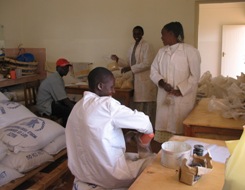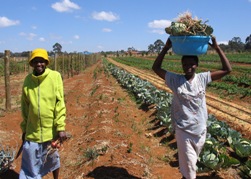Nutrition Distribution System for HIV Patients in Kenya
Purdue University
The Academic Model for the Prevention and Treatment of HIV/AIDS (AMPATH) program was established by Indiana University and Moi University to provide healthcare services to combat HIV in rural Kenya. Malnutrition and food insecurity are common among AMPATH patients. A nutrition system was needed to distribute food supplements to thousands of food-insecure HIV-infected patients and their families based on a nutritionist’s prescription written during routine evaluation at clinic enrollment. In 2005, the size and complexity of the AMPATH nutrition program began to overwhelm its operators. In response, the School of Industrial Engineering (IE) at Purdue University and the Regenstrief Center for Healthcare Engineering joined the AMPATH collaboration in an effort to resolve food distribution difficulties.

The Purdue IE team, led by Professor Yuehwern Yih, designed and implemented the AMPATH Nutrition Information System (NIS) currently deployed at the Moi Teaching and Referral Hospital, Kenya’s second national referral hospital, located in Eldoret, Kenya. The system manages the ordering, storage, packing, shipping, and distribution of fresh produce from AMPATH farms and dry food supplements from the World Food Program (WFP) and the U.S. Agency for International Development (USAID).
The NIS triggers the food packing and delivery operations based on the demand qualities derived from patient nutrition prescriptions at each distribution site. In addition, this information system is connected to the AMPATH patient electronic medical records, where the impact of nutrition on clinical outcomes can be further studied.

In addition to the information system development, the Purdue IE team also analyzed the food demand and supply patterns to design the physical logistic system to distribute dry food as well as fresh produce to AMPATH patients and their families. This includes
- the number and the locations of the warehouses and packing centers
- the types and the number of transportation vehicles
- the space requirement and the layout design of packing centers and distributing sites
- the number of workers at each facility
- the schedule of shipping and receiving dry food from donors and fresh produce from farms
- the design of information flow and the procedures for food distribution and information transfer
As of February 2009, there had been 80,000 patients enrolled in the AMPATH program and the enrollment continues to grow when the AMPATH program opens new clinics in rural Kenya.

- For further information, please contact Professor Yuehwern Yih
- E-mail: yih@purdue.edu